We look at the structure of the Internet in Ukraine and how it may be helping the country stay connected.
At the end of the second week of the Russian invasion of Ukraine, the devastating effects of this war are very visible in mainstream media. Over two million people have fled the violence so far, and immense damage is being done to cities, towns and villages across the country.
In spite of all that is happening, the Ukrainian Internet appears to be holding up. And while it is terrible to see the resiliency of a country's Internet tested in this way, it is good to see that it is still functioning. There has been some speculation as to why this is. For example, it may be that the Ukrainian Internet is deliberately not being targeted by the invaders. Or it may be that it is structured in such a way that makes it hard to attack.
In this article, we take a closer look at certain factors that may be contributing to the the resiliency of the Ukrainian Internet.
Lack of market concentration at end-user networks
One interesting dimension of the Ukrainian Internet is the lack of market concentration in the end-user market. If we calculate the Herfindahl Hirschman index (HHI), an economic indicator for market concentration, we find that Ukraine is one of the least concentrated markets worldwide. Note that we calculate the HHI based on APNIC data for which networks serve users in a particular country. From this data we take all networks with over 1% users for the particular country, and from that we calculate HHI. Because we convert from percentages to fractions (divide by 100) we get an HHI between 0 (not concentrated) and 1 (monopoly):
| Country | HHI | |
|---|---|---|
| 1 | Brazil | 0.018 |
| 2 | Russia | 0.047 |
| 3 | United States | 0.05 |
| 4 | Ukraine | 0.052 |
| 5 | Lebanon | 0.067 |
| 6 | Singapore | 0.069 |
| 7 | Albania | 0.072 |
| 8 | Guadelope | 0.081 |
| 9 | South Africa | 0.083 |
| 10 | Japan | 0.087 |
Why is this important? There are no dominant players in the market, so if an individual network goes down, this has a relatively small effect on the whole network.
It is also relevant to note that, for the most part, the networks with significant amounts of users are Ukrainian companies. For the Russian regime to shut down Ukrainian networks, they would have to force these Ukrainian companies to do so. This is different from situations where a government shuts down the Internet in the country it governs, as we saw in Egypt in the Arab Spring. In that case, the Egyptian government ordered Egyptian networks to shut down the Internet and the networks complied.
We also look at how these networks are interconnected. For the networks where we have RIPE Atlas probes, we can measure the path between these networks. This is depicted in Figure 1:
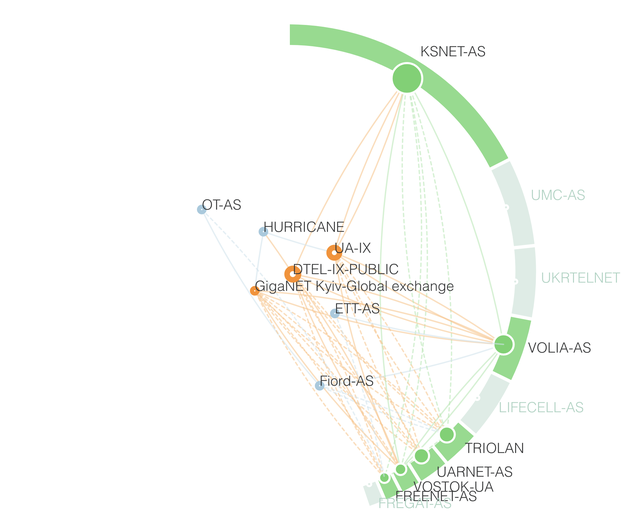
The outer ring of this visualisation represents end-user networks. For this visualisation, the only networks that are shown (as green arcs) in the circle are those that serve over 1% of the population of the country. In the case of Ukraine, you see a large 'gap' in the left side of circle (roughly 55%). This is due to the fact that more than half of the networks serving end-users in Ukraine serve less than 1% of the population.
For the networks that we have data for, you can see that there are many options between the networks, we either see them directly interconnecting, or interconnection is mediated by one of the many Internet Exchange Points (IXPs) in Ukraine (depicted by orange circles in Figure 1). Note that we don't directly observe resiliency, because the paths that we measure are the active paths, and due to how Internet routing works, we can't see backup paths until they are activated.
Resiliency in IXPs
Zooming in on the IXPs, we see 19 IXPs in Ukraine listed in PeeringDB:
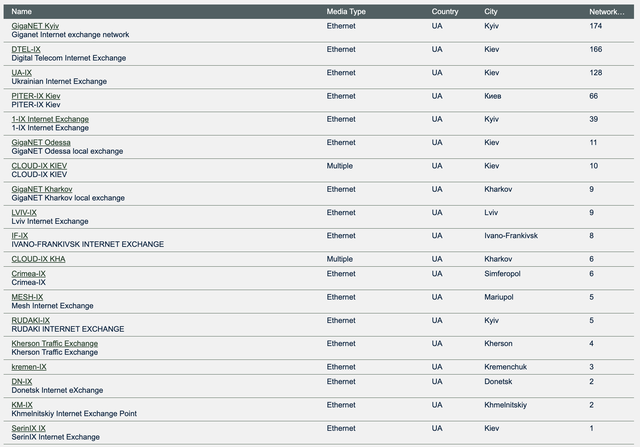
If we measure the path between all networks that we have RIPE Atlas probes in, we see 13 IXPs in these paths. This indicates there are a lot of IXPs active, which facilitates resilient interconnection. We visualise the paths between probes in Figure 3. Each cell here represents a path between RIPE Atlas probes in Ukraine, and you can see that the majority of these paths are mediated by IXPs (the total of coloured cells). It's also striking how many different IXPs are used, indicating that there is not a single dominant IXP.
Probes are ordered north (top left of Figure 3) to south (bottom right).
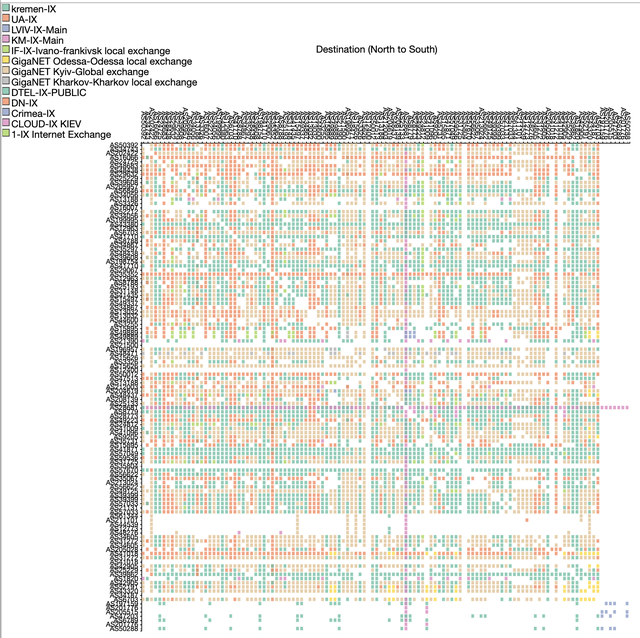
Market concentration at transit networks
If we move our focus to transit networks, we see similar patterns. For the influence (directly and indirectly) of networks over particular countries, we look at the AS Hegemony scores in the Internet Health Report. This data is derived from RIPE RIS and Routeviews, and these hegemony scores indicate how influential one network is over a part of the Internet. For instance how influential a particular ISP is over the population of users in a particular country. This is what that looks like for Ukraine:
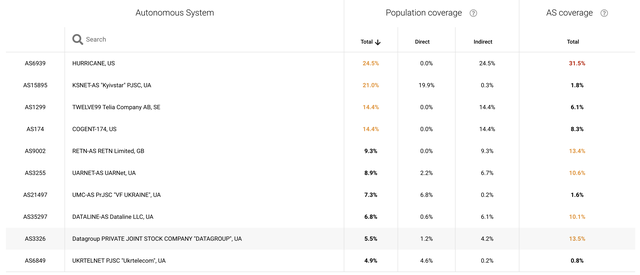
We can also calculate this score for the influence of a particular ISP over the networks in a particular country (the difference is that not all networks have the same number of users, so in the first case the influence is weighted over users, the second it's weighted over networks).

If there are networks that Ukrainian networks depend on, these seem to be the large international players, many of them so called "tier1" networks, and note that Russian transit networks are absent.
Mobile vs Fixed Internet
The data we collect and see is mostly about the fixed Internet. Insights into what happens with mobile Internet are a lot harder to obtain from the data we collect in RIPE RIS and RIPE Atlas. The best public data we found on this is in Cloudflare Radar. This data shows how, during the beginning of the war, the traffic they received shifted towards more mobile use. This also explains the slow but steady decline we see indicators of the fixed Internet (for instance the number of connected RIPE Atlas probes). With 2 million people fleeing in a country of 44 million people, it is expected that the fixed Internet is less used, due to people shutting down their home and/or office Internet routers.
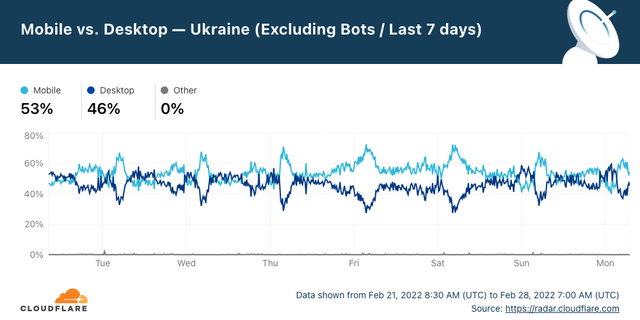

Other similar indicators of user activity see the same trend; e.g. Google transparency report, Gatech IODA.
The Physical Layer
In the end, the Internet infrastructure in Ukraine is a man-made structure, at the very core consisting of routers, a transport medium (fibre mostly) and electricity to power it all. Loss of power or extensive damage to the underlying fibres would mean no more physical connectivity; i.e. the Internet stops working.
Cables
There is a really good explanation of the role physical fibres play in keeping the Internet in Ukraine connected from Telegeography . What we see there also suggests resilience on the physical layer. In short, there are diverse fibre paths from multiple organisations providing services over these fibres.
That said, physical infrastructure is being damaged in specific parts of the country. Even as that is happening, though, engineers on the ground are doing incredible work to carry out repairs under profoundly difficult circumstances (more on this below).
Power
Internet infrastructure needs electricity to function. With power going out in Mariupol, we are hearing reports of the devastating effects this is having on people in the city, which of course go well beyond loss of Internet connectivity alone.
Focusing on the Internet here, though, we do indeed see that with this loss of power, Internet connectivity appears to have been badly affected in the city. An example of this is the local provider CDS, who operate out of Mariupol. This ISP, which represents 0.3% of all users in Ukraine, went dark on the night of the 28 February (see Figure 8). Again, despite the resilience of the Ukrainian Internet, we are seeing damage as a result of the war.
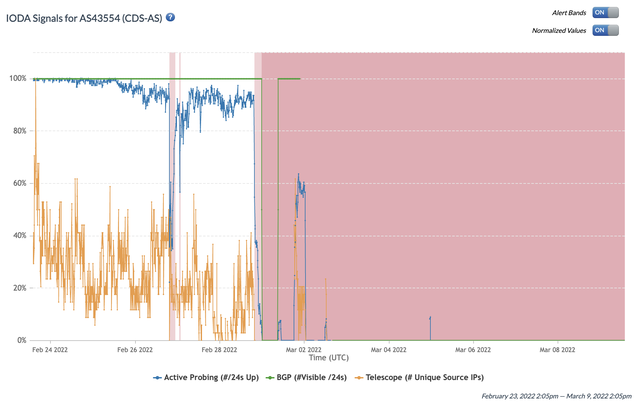
Humans
There are other indications of the determination of network operators in Ukraine to keep the Internet running. We see outages, but also quick recovery of networks, in what can only be obscenely difficult circumstances. We reported on the sabotage of Triolan earlier. Another example of this is Ukrtelekom, which serves around 5% of the Ukrainian population. They had an outage on the morning of 8 March, but this only lasted for 3 hours thanks to the efforts of network operators.
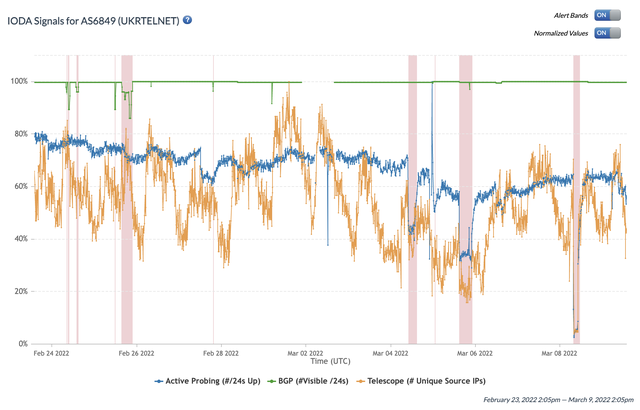
According to reports that we have received from the ground, network operators from different providers are teaming up to help each other - for example by repairing fibres - so as to make sure that the people relying on the Internet are able to keep on communicating with one another.
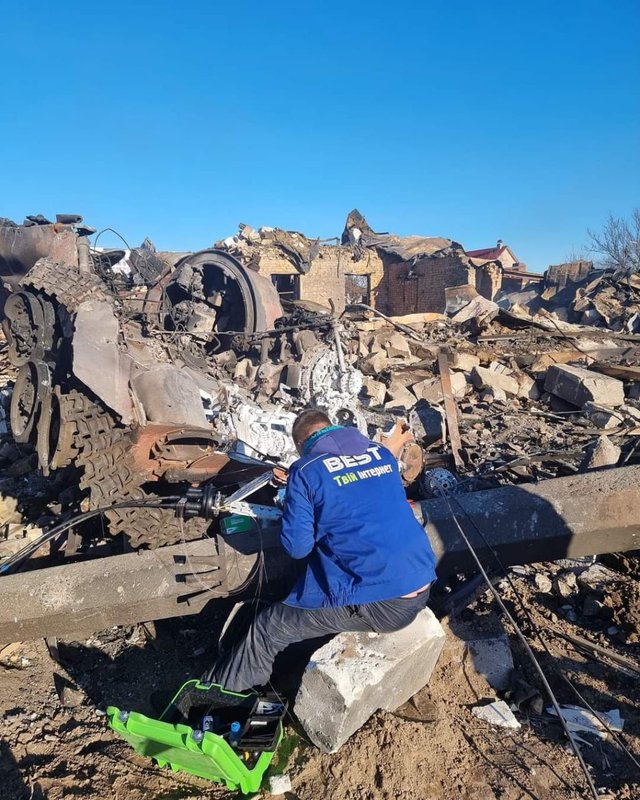
Conclusion
We hope to have provided some insights as to why the Ukrainian Internet is remaining resilient under these dire circumstances. Due to low market concentration at multiple levels and the relatively high number of interconnect facilities, there are no obvious chokepoints, or individual networks whose loss would have a crippling effect on the Internet in Ukraine. Qrator resilience ratings suggest the same.
But there is a break-point for all infrastructure. For instance, if power goes out, or if there are large scale physical disruptions, these likely will have significant effects on the Internet in Ukraine. As we receive more information about power shortages, this can have an effect on the Internet in Ukraine as a whole.
For more background on the Ukrainian Internet we refer to Alex Semenyaka's presentation at the Kyiv Internet days in 2019.
Again, our thoughts are with the Ukrainian people, and we continue to hope for a peaceful resolution of this conflict soon. We encourage anyone who knows of specific efforts to help Ukrainian network operators to leave further information on those efforts in the comments below.

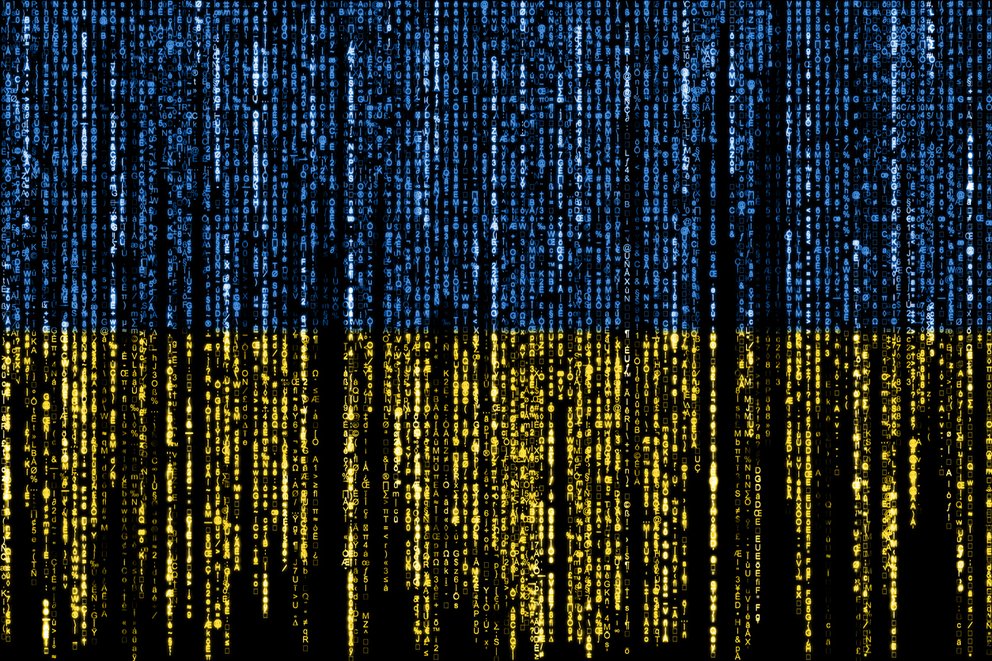



Comments 3
The comments section is closed for articles published more than a year ago. If you'd like to inform us of any issues, please contact us.
Emile Aben •
We got a request for the HHI scores for other countries. I've put these in a small repo on github together with the code that generated this. repo: https://github.com/emileaben/hhi-eyeballs HHI scores for 2022-03-07 are available here: https://raw.githubusercontent.com/emileaben/hhi-eyeballs/main/eyeball-hhi.2022-03-07.csv
Emile Aben •
An effort related to keeping Urkanian servers/websites online by the Dutch Cloud Community: https://dutchcloudcommunity.nl/community/cloud4ukraine/
Emile Aben •
NOG Alliance is helping out network operators in Ukraine: https://nogalliance.org/our-task-forces/keep-ukraine-connected/